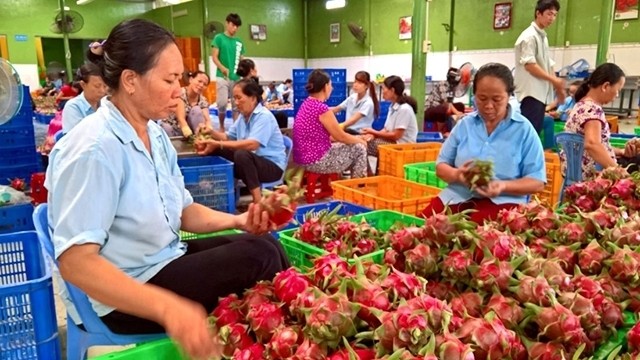According to the Ministry of Agriculture and Rural Development (MARD), currently, there are about 989,000 hectares of fruit trees nationwide with an average yield of more than 10 tonnes per hectare. Fruit output reaches 9 million tonnes per year.
Many localities have established large-scale and high quality fruit tree growing areas such as Luc Ngan litchi (Bac Giang province), Thanh Ha litchi (Hai Duong); longan (Hung Yen, Son La, Tien Giang and Vinh Long); Bac Ha plum (Lao Cai); orange (Ha Giang, Tuyen Quang, Vinh Long, Hau Giang); mango (Son La, Khanh Hoa, Dong Nai, Dong Thap, An Giang); grapefruit (Hanoi, Phu Tho, Ben Tre, Vinh Long); dragon fruits (Binh Thuan, Long An, Tien Giang); pineapple (Ninh Binh, Thanh Hoa, Tien Giang, Kien Giang); and rambutan (Dong Nai, Ben Tre), etc.
Currently, the main fresh fruit products of Vietnam such as dragon fruit, mango, rambutan, star apple, and longan have been expected to reach fastidious markets such as the US, the EU, Canada and Australia. By the end of 2018, the MARD has granted codes for 452 orchard growing regions with a total area of over 7,600 hectares.
The market opening requires a lot of investment and time, if fruits don’t meet the import requirements, the risk of market loss is very high. This is because countries are tending to improve technical barriers on plant quarantine and food safety. However, at present, there is a lack of in-depth and comprehensive studies and forecasts on the needs and tastes of consumers in key markets as well as competitors with Vietnamese goods.
Moreover, currently, most of the fruit exporting enterprises in Vietnam are run on a small scale with limited capacity and inefficient export organisation. There is a phenomena of unfair competition among businesses as well as weak connection among farmers, exporters and research facilities. The technology involving preservation and post-harvest handling still remains weak.
According to the Plant Protection Department, in order to develop sustainable orchard growing areas, ministries, branches and localities should formulate an appropriate market opening strategy, with a focus on meeting requirements of large markets, improving transportation services and developing products with competitive advantages such as dragon fruit, longan, rambutan, grapefruit, mango, etc.
More attention should also be paid to planning and developing concentrated production areas for key export products; facilitating the issuing of codes for orchard growing areas; supervising the compliance with regulations on plant quarantine and food safety in planted areas where export codes have been issued; promulgating mechanisms and policies to promote production linkages as well as the application of biological measures in production; and promoting production linkages among farmers, export enterprises and scientific research institutions in an effective and sustainable manner.
















